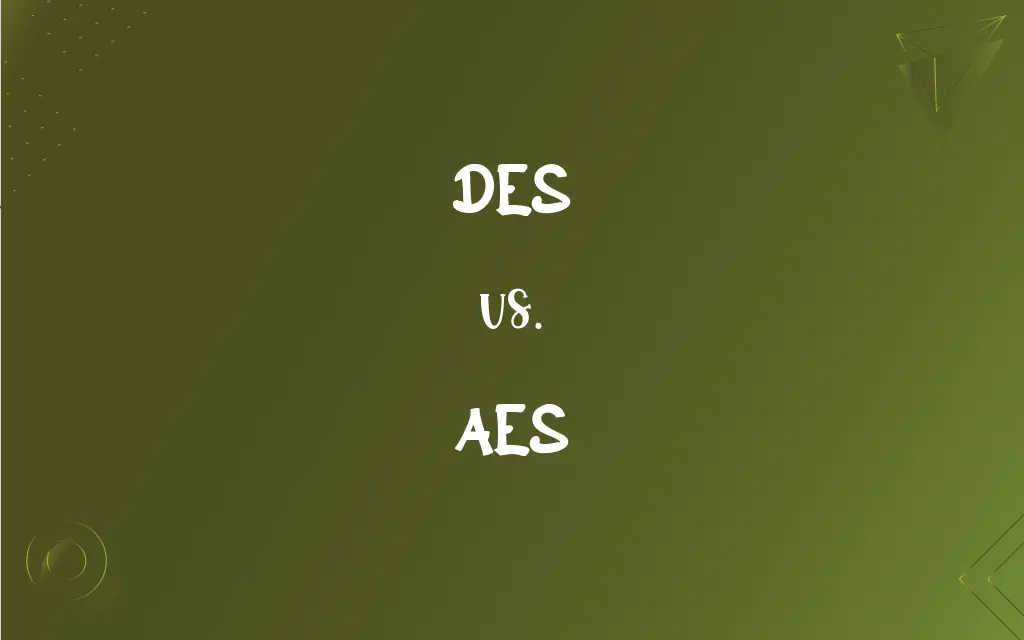DES vs. AES: What's the Difference?
Edited by Aimie Carlson || By Harlon Moss || Published on February 20, 2024
DES (Data Encryption Standard) is an older, less secure encryption algorithm than AES (Advanced Encryption Standard), which is more complex and secure.

Key Differences
Data Encryption Standard (DES) and Advanced Encryption Standard (AES) are both symmetric-key algorithms used in cryptography. DES, developed in the 1970s, was once the standard for encryption but has since been considered insecure due to its shorter key length. In contrast, AES, established in the early 2000s, offers enhanced security through longer key lengths and has become the preferred choice for modern encryption needs.
The key difference between DES and AES lies in their key lengths and security. DES uses a 56-bit key, making it vulnerable to brute-force attacks, while AES can use 128, 192, or 256-bit keys, significantly increasing security against such attacks. This key length variation makes AES more adaptable and secure compared to DES.
DES and AES differ in their encryption processes. DES employs a 16-round Feistel structure, where the data is divided into blocks and encrypted in a series of steps. AES, however, uses a more complex process involving substitutions, permutations, and mixing of the data blocks, which enhances its resistance to various cryptographic attacks.
In terms of performance, AES is more efficient than DES, especially on modern hardware. DES's simpler algorithm was suited for the hardware of its time but struggles with today's computing power. AES's design, on the other hand, takes advantage of modern processors, leading to faster and more secure encryption.
DES was widely adopted in the past, its usage has significantly declined due to its vulnerability. AES, being more secure, has seen widespread adoption across various industries and is recommended by cybersecurity experts and organizations worldwide for encrypting sensitive data.
ADVERTISEMENT
Comparison Chart
Full Name
Data Encryption Standard
Advanced Encryption Standard
Key Length
56 bits
128, 192, or 256 bits
Block Size
64 bits
128 bits
Security Level
Less secure, vulnerable to brute-force attacks
More secure, resistant to modern cryptographic attacks
Usage Era
Developed in 1970s, now largely obsolete
Developed in ea
ADVERTISEMENT
DES and AES Definitions
DES
DES is a symmetric-key block cipher.
The bank used DES for encrypting transactions in the 1990s.
AES
AES offers flexibility in key lengths.
AES's various key lengths make it adaptable to different security needs.
DES
DES was initially designed by IBM.
IBM's involvement in DES's design was crucial in its early development.
AES
AES is a widely used symmetric encryption algorithm.
AES encrypts sensitive government data due to its high security.
DES
DES was standardized by the National Institute of Standards and Technology (NIST).
DES's approval by NIST marked a significant moment in cryptographic history.
AES
AES was selected through a public competition.
The selection of AES was a result of a global search for a DES successor.
DES
DES operates on 64-bit blocks of data.
Each 64-bit block in DES is encrypted using the same secret key.
AES
AES encrypts data in 128-bit blocks.
In AES, data is encrypted block-by-block for enhanced security.
DES
DES is now considered insecure for many applications.
Modern systems have replaced DES with more secure encryption methods.
AES
AES is used in numerous applications worldwide.
From online banking to secure communications, AES is a go-to encryption choice.
DES
Desflurane.
AES
(rare) a, the name of the letter A.
DES
Plural of de
DES
A potent estrogen used in medicine and in feed for livestock and poultry
DES
Synthetic nonsteroid with the properties of estrogen; formerly used to treat menstrual problems but was found to be associated with vaginal cancers in the daughters of women so treated during pregnancy
FAQs
Who developed DES?
DES was developed by IBM and standardized by NIST.
How secure is DES?
DES is now considered less secure due to its 56-bit key length.
Is DES still used today?
DES is largely obsolete and replaced by more secure standards like AES.
What is DES?
DES is a symmetric-key block cipher once widely used for data encryption.
What is AES?
AES is a symmetric encryption algorithm, widely used for secure data encryption.
Can AES be used for personal data encryption?
Yes, AES is suitable for encrypting personal and sensitive data.
Are there any common applications where both DES and AES are used?
Both were used in various encryption applications, but AES has largely replaced DES.
What industries rely on AES encryption?
Industries like finance, healthcare, and government rely on AES for secure data encryption.
What are common uses of DES?
DES was commonly used in banking and government communications, but less so now.
Why was DES replaced by AES?
DES was replaced due to vulnerabilities and the need for a more secure encryption standard.
What are the block sizes of DES and AES?
DES uses a 64-bit block size, while AES uses a 128-bit block size.
Can DES and AES be used interchangeably?
Due to security differences, it's not recommended to use DES where AES is applicable.
Are there any variants of DES and AES?
DES has variants like 3DES, while AES's flexibility lies in its variable key lengths.
Is AES more secure than DES?
Yes, AES is more secure due to longer key lengths and a more complex algorithm.
How does the encryption process differ between DES and AES?
DES uses a simpler Feistel network, while AES employs a more complex series of substitutions and permutations.
What key lengths does AES support?
AES supports key lengths of 128, 192, and 256 bits.
What impact did IBM have on the development of DES?
IBM significantly contributed to the initial design and development of DES.
Is AES encryption faster than DES?
Yes, AES is generally faster and more efficient, especially on modern hardware.
How was AES selected?
AES was selected through a public competition to find a successor to DES.
Has AES been compromised or broken like DES?
As of now, there is no practical method to break AES with current technology.
About Author
Written by
Harlon MossHarlon is a seasoned quality moderator and accomplished content writer for Difference Wiki. An alumnus of the prestigious University of California, he earned his degree in Computer Science. Leveraging his academic background, Harlon brings a meticulous and informed perspective to his work, ensuring content accuracy and excellence.
Edited by
Aimie CarlsonAimie Carlson, holding a master's degree in English literature, is a fervent English language enthusiast. She lends her writing talents to Difference Wiki, a prominent website that specializes in comparisons, offering readers insightful analyses that both captivate and inform.































































